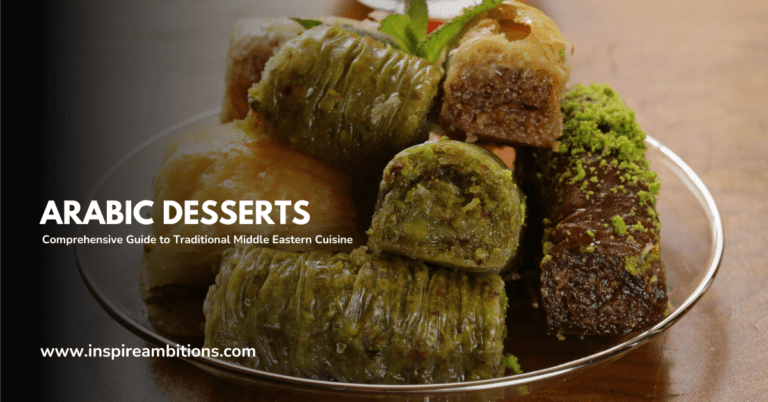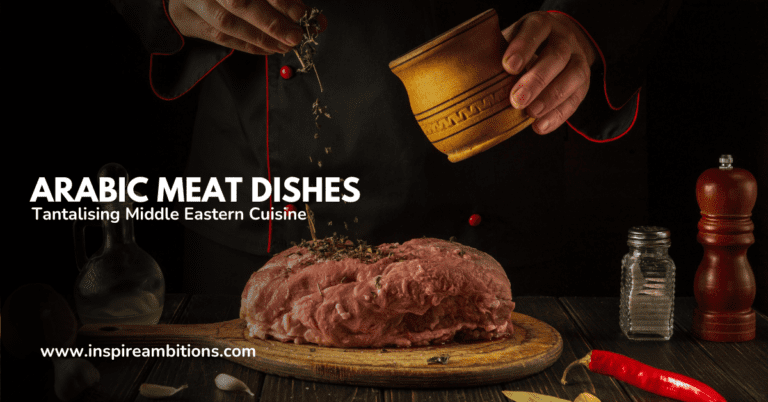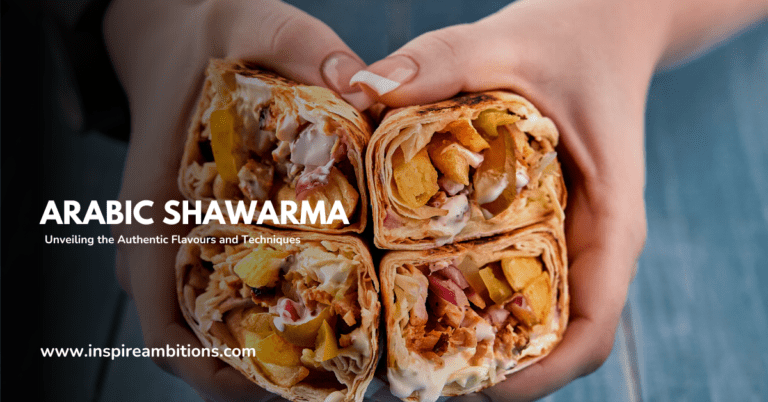Comida árabe Kuba: un sabroso viaje culinario
Kuba, also known as kibbeh or kubba, is a versatile Arabic dish that has become popular in many countries of West Asia. At its core, Kuba is a delicious blend of spiced ground meat, onions, and grain. With various regional adaptations, this dish takes on different forms, creating a unique culinary experience.
As you explore the world of Kuba, you’ll find that it appears in numerous variations. Some common forms include Kubba Mosul, which is a Middle Eastern meat pie; Kubba Halab, which are meat-filled rice balls; and Kubba Hamuth, which are meat dumplings served in soup.
Each version offers diverse flavours and textures, making Kuba a popular and beloved dish across the Arab world.
Embraced by multiple cultures, Kuba is not only a tasty dish but also a testament to the rich history, regional influences, and culinary creativity of Arabic cuisine. Sampling different variations of Kuba, you’ll embark on an exciting journey filled with vibrant flavours and lasting culinary memories.
The History of Kuba Arabic Food
When you explore Kuba, an Arabic dish, you’re delving into a rich culinary tradition. The term Kuba (also known as kibbeh or kubba) originates from the Arabic verb كَبَّبَ (kabbaba), which means “to form into a ball”.
This food has a special significance in Levantine cuisine, where various dishes are prepared using a combination of bulgur (cracked wheat) and minced lamb. Aleppo, a city in Syria, is particularly famous for offering more than 17 types of Kuba.
As you look back to the origins of Kuba, it is important to note how the arrival of Arabs in the 7th century on the eastern Mediterranean shores and in North Africa influenced the dish’s development.
When they encountered and later occupied these regions, they discovered a wide array of foods, some dating back to the beginnings of civilised history. The synthesis of local ingredients and Arab culinary techniques led to the creation of unique dishes like Kuba.
Over time, variations of Kuba emerged in different regions across the Middle East. For instance, the Iraqi version of Kuba features minced lamb, rice, sultanas, and saffron for a distinct flavour and colour.
Additionally, there are some versions with a crispy outer shell made from rice or semolina, filled with meat and various spices. These delectable treats are often fried or baked and served as appetisers or main dishes.
In learning about Kuba, you are not only unravelling the story of a beloved comida arabica but also immersing yourself in the historical layers that have shaped the Middle Eastern culinary landscape.
From Aleppo to the shores of the Mediterranean, Kuba remains an enduring testament to the intricate and diverse world of Arabic cuisine.
Essential Ingredients in Kuba Arabic Food
Kuba, known as kibbeh, kubbeh, or içli köfte, is a popular Arabic dish known for its unique combination of flavours and textures. Let’s explore the essential ingredients that make Kuba a delicious and satisfying meal.
Rice in Kuba
Rice serves as the primary component of many Kuba recipes, providing both structure and flavour to the dish. Long-grain rice, such as basmati, is commonly used for its ability to retain its shape and texture during cooking.
In some variations, like Kubba Halab, the rice is mixed with a small amount of oil and then air-fried to achieve a crispy outer layer, whilst maintaining a soft, tender interior.
Meat in Kuba
Meat is the other core ingredient in Kuba, and it often includes ground beef, lamb, or even chicken. The meat is usually seasoned with a blend of aromatic spices and mixed with onions to add depth of flavour.
In certain preparations, additional ingredients like raisins, pine nuts or slivered almonds may be added to the meat filling for an extra layer of taste and texture.
Spices in Kuba
Spices play a crucial role in Kuba, imparting warmth and complexity to the dish. Commonly used spices include
- Comino: A warming spice with an earthy, aromatic flavour.
- Turmeric: A fragrant spice, lending a mild, slightly bitter taste and a vibrant yellow colour.
- Ground Basra (black) lime: An essential ingredient in some Kuba recipes, contributing a tangy, citrusy flavour.
- Red pepper flakes: A kick of heat, adding a touch of spiciness to the dish.
- Saffron strands: Delicate threads that infuse the rice with a subtle aroma and a golden hue.
The combination of rice, meat and spices in Kuba creates a harmonious blend of flavours and textures that are popular across many countries of West Asia.
Cooking Process of Kuba Arabic Food
To begin with, you’ll need to prepare the outer shell by combining bulgur or rice with meat and spices. For example, you can soak bulgur in warm water for 10 minutes to soften it before adding semolina or rice flour, meat, salt, and allspice. Knead the mixture thoroughly with your hands until it’s completely mixed.
For the filling, use minced lamb combined with finely diced onion, chopped parsley, sultanas, peas, and a blend of spices like cumin, turmeric, and ground black lime.
You’ll form the Kuba by taking a portion of the outer shell mixture and creating a thin layer of it around a small amount of filling. It’s essential to practice forming this outer shell to achieve an even, thin layer without tearing or having the filling poke through.
When you’ve formed your rice balls or patties, heat vegetable oil to 375°F (190°C) in a pan. Fry the Kuba for approximately 4 minutes, or until they turn golden brown, making sure to flip them halfway through the cooking process. The result should be a crispy, flavourful outer shell surrounding a tender, spiced meat filling.
During the frying process, be consciente de of overcrowding the pan to ensure even cooking and prevent sticking. You may need to work in batches, depending on the size of your pan. It’s also important to maintain a consistent oil temperature, as this directly affects the Kuba’s cooking time and texture.
Once cooked, place the Kuba onto a paper towel-lined plate to drain any excess oil before serving. Kuba comida arabica is best enjoyed hot and can be served with various dips, sauces, or side dishes, such as hummus or tabbouleh.
Enjoy this delicious, traditional Middle Eastern dish and impress your friends and family with your culinary skills.
Significance of Kuba in Arabic Culture
Kuba, also known as kibbeh, is a dish with deep roots in Arabic cuisine and culture. This delicious and versatile dish has been a staple in Arab communities for generations, and it is enjoyed by people from all walks of life.
You may have tried it in various forms, such as fried goods, dumplings, or even as a simple but scrumptious pastry filled with spiced meat.
The origins of Kuba can be traced back to the cuisines of West Asia. It is popular in many countries across the region, including Iraq, Lebanon, and Syria. The dish is often enhanced with local ingredients and spices, making it a true representation of regional tastes and traditions.
One significant aspect of Kuba in Arabic culture is its symbolic role in hospitalidad. Serving Kuba to guests is seen as an expression of warmth and respect, as the dish requires time and effort to prepare.
Many families pass down their Kuba recipes through generations, with each family bringing its unique flavours and techniques to the table.
In addition to its cultural symbolism, Kuba is highly versatile, and you can find it in various forms across Arabic cuisine.
It can be served as an appetiser, a main dish, or even a snack. It is typically made using ground meat, onions, and grain, such as bulgur wheat or rice, and is seasoned with a variety of spices, including allspice, cinnamon, and cumin.
As you explore the world of Arabic cuisine, Kuba offers you a chance to appreciate the rich heritage and diverse culinary influences in this fascinating region.
As you savour the flavours and textures of Kuba, you are not only enjoying a delightful meal, but you are also taking part in a cherished culinary tradition with a long and storied history.
Regional Variations of Kuba
The regional variations you should try:
Kuba in Iraq
In Iraq, Kuba is known as Kubbat Shorba and is prepared as a stew, often made with turnips and chard in a tomato-based sauce.
This hearty dish is typically served with arak and various salads to enhance the flavours. You can find this Iraqi version of Kuba in many Middle Eastern food places and it is a popular choice for those who enjoy Middle Eastern cuisine.
Kuba in Lebanon
Lebanese Kuba, often called kibbeh, is a unique take on the dish that is traditionally made with minced meat, bulgur wheat, and a variety of spices. In Lebanon, you can find kibbeh served as small, torpedo-shaped balls, or flat patties.
They are commonly deep-fried and enjoyed as a snack or as part of a larger meal. In addition to the main ingredients, some variations of Lebanese Kuba may include pine nuts, onions, and other flavourful additions.
Kuba in Palestine
Palestinian Kuba, also called kubbeh, is a popular dish with an array of local variations. One of the most common types you’ll encounter is called kubbeh in yoghurt sauce (kubbeh labanieh).
This dish consists of kubbeh balls made from bulgur wheat and minced meat, cooked in a tangy yoghurt sauce with butter, and typically served alongside rice. Another popular variation is called kubbeh summaqiyeh, which is cooked with sumac and features a sour flavour profile.
Whichever type you come across, rest assured that Palestinian Kuba is a delicious and satisfying meal worth trying.
Health Benefits and Nutritional Value of Kuba Arabic Food
Kuba, also known as kibbeh, comes from a family of dishes widely popular in many West Asian countries. It is made with spiced ground meat, onions, and grain. In terms of health benefits, Kuba has several characteristics that make it a good choice for a well-rounded meal.
First, Kuba is high in protein, coming from the ground meat, which is often lamb or beef. Protein is essential for muscle growth and repair, and it also helps keep you feeling full for longer periods. This can be beneficial in assisting with weight management and maintaining a healthy lifestyle.
Additionally, Kuba is made with whole grains, such as bulgur wheat, which offers several health benefits. Whole grains are excellent sources of dietary fibre, which aids digestion and supports a healthy gut.
They are also rich in essential nutrients like iron, magnesium, and B vitamins. Consuming whole grains can help reduce your risk of developing chronic diseases such as heart disease, diabetes, and some types of cancer.
comida arabica, including Kuba, often contains healthy fatty acids, which are beneficial for your overall health. These foods are usually rich in monounsaturated and polyunsaturated fats, like olive oil, which help lower cholesterol and reduce inflammation.
In contrast, consuming too many unhealthy fats, like saturated and trans fats, can lead to chronic health problems, such as obesity and heart disease.
Kuba is typically seasoned with various spices, such as cumin and turmeric, which not only add flavour but contribute to its health benefits.
Many spices have antioxidant and anti-inflammatory properties, which can help protect your body from cellular damage and reduce inflammation, a known factor in the development of many chronic diseases.
In terms of nutritional valor, here are some general guidelines for a serving of Kuba:
- 1 serving (approximately 100g)
- Calories: 250-300 kcal
- Protein: 12-15g
- Carbohydrates: 30-35g
- Dietary Fibre: 3-4g
- Fat: 10-12g
Please note that these values can vary depending on specific ingredients and preparation methods.
To summarise, Kuba Arabic food is rich in protein, beneficial fats, whole grains, and spices that provide various health benefits. Including Kuba in your diet can contribute to a balanced and nutritious meal while enjoying the delicious flavours of West Asian cuisine.
Serving and Eating Kuba Arabic Food
Kuba, also known as kibbeh, is a popular Arabic dish made with spiced ground meat, onions, and grain. When preparing to serve Kuba, consider including a variety of accompaniments and side dishes to enhance the dining experience.
Start by presenting Kuba on a large platter, arranging the patties or pies in an attractive manner. You might also choose to garnish the dish with parsley, mint, or other fresh herbs to add colour and flavour. Accompany your Kuba with a selection of dips, such as hummus, baba ganoush, or yoghurt sauce for a flavourful and diverse meal.
Side dishes play a crucial role as well, offering a balance of flavours and textures. A traditional choice would be a Middle Eastern salad, comprised of vegetables like tomatoes, cucumber, and onions, dressed with olive oil and lemon juice.
Additionally, serving warm pita bread or other flatbreads will allow guests to scoop up bites of Kuba and dips with ease.
When eating Kuba, you can use your hands or utensils, depending on your personal preference and cultural norms. Dip the Kuba into the sauces or enjoy it together with a forkful of salad for a harmonious blend of tastes.
Don’t hesitate to get creative with your pairings, as the versatile flavours of Kuba can harmonise well with a variety of dishes.
Finally, remember to enjoy the social aspect of sharing a Kuba meal with friends and family. The communal nature of this dish invites conversation and connection, making it a highly enjoyable dining experience.
Pairing Kuba with Other Arabic Dishes
When enjoying Kuba, a delicious Middle Eastern dish consisting of spiced ground meat, onions, and grain, you might wonder how to best pair it with other Arabic dishes. Don’t worry, we’ve got you covered! With a few simple food pairings, you can create a delightful and harmonious meal.
To begin with, consider serving Kuba alongside some flavourful dips and starters. Hummus, baba ghanoush, or mutabbal all make excellent accompaniments, as their rich flavours complement the spiced meat in Kuba. Spread these dips on warm pita bread or enjoy them with crunchy vegetable sticks.
Next, you can balance the heavier meat component of Kuba with some light and refreshing salads. Tabbouleh, a tangy parsley and bulgur wheat salad, or Fattoush, a mixed vegetable salad with crispy pita pieces, both make great choices. Their bright and zesty flavours will help cleanse your palate in between bites of Kuba.
Pairing Kuba with a grain-based side dish is another way to create a more filling and satisfying meal. Consider serving it with basmati rice, flavoured with saffron or turmeric, or even a buttery couscous. These sides will soak up any tasty juices from the Kuba, ensuring you savour every last drop of flavour.
Finally, to round out your Arabic dining experience, don’t forget to offer a few beverages to complement your meal. A glass of fresh mint lemonade or some traditional Arabic coffee infused with cardamom would be perfect choices for both quenching your thirst and enhancing the overall taste of your Kuba meal.
With these pairing ideas in mind, you’re now prepared to enjoy Kuba in combination with a variety of other Arabic dishes. The flavours and textures of these pairings will enhance your dining experience, allowing you and your guests to fully appreciate the wonderful world of Arabic cuisine.
Modern Take on Kuba Arabic Food
Kuba, also known as kibbeh or kubbeh, is a beloved dish in Arabic cuisine. In recent years, contemporary chefs have been exploring new ways to prepare and present this traditional delight. If you’re a fan of kuba or simply intrigued by its rich history and tantalising flavours, here are some modern adaptations to try.
Firstly, consider experimenting with the ingredients. Kuba typically consists of spiced ground meat, onions, and grain. Instead of the more conventional lamb or beef, you may opt for leaner meats like chicken or turkey. For a vegetarian or vegan twist, substitute meat with mushrooms or plant-based alternatives.
Another innovative approach to kuba is deconstructing the dish. Traditionally, kuba is prepared as a pie or fried patties.
Deconstructed kuba can be served as a salad or bowl, combining individual elements like seasoned ground meat, cooked grains, and sautéed onions. Add an assortment of fresh vegetables or leafy greens for an even healthier twist.
If you’re seeking a gluten-free option, replace bulgur or semolina with cooked quinoa, millet, or even cauliflower rice. These grains and grain alternatives not only cater to dietary restrictions but also add unique flavours and textures to your kuba dish.
Incorporating fusion elements can also elevate kuba to new heights. For example, you can blend the rich flavours of kuba with the fresh crunch of Vietnamese spring rolls, wrapping the mixture in delicate rice paper.
Another idea is to serve kuba in the style of Spanish tapas, creating small individual servings for an interactive dining experience.
As you explore these modern takes on kuba Arabic food, keep an open mind and remain true to the spirit of this timeless dish.
By experimenting with new ingredients, presentations, and combinations, you’ll not only satisfy your taste buds but also gain appreciation for the culinary versatility of this Middle Eastern classic.







